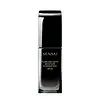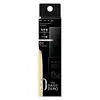What's inside
What's inside
 Key Ingredients
Key Ingredients

 Benefits
Benefits

 Concerns
Concerns

 Ingredients Side-by-side
Ingredients Side-by-side

Water
Skin ConditioningMethyl Trimethicone
Skin ConditioningEthylhexyl Methoxycinnamate
UV AbsorberTitanium Dioxide
Cosmetic ColorantPhenyl Trimethicone
Skin ConditioningSilica
AbrasiveCaprylyl Methicone
Skin ConditioningTalc
AbrasiveDipropylene Glycol
HumectantPEG-10 Dimethicone
Skin ConditioningMaltitol
HumectantDimethicone
EmollientAcrylates/Dimethicone Copolymer
Skin ConditioningDiglycerin
HumectantNeopentyl Glycol Dicaprate
EmollientStearic Acid
CleansingAluminum Hydroxide
EmollientSodium Chloride
MaskingSorbitan Isostearate
EmulsifyingPhenoxyethanol
PreservativeChlorphenesin
AntimicrobialIsopropyl Titanium Triisostearate
EmollientHydrogenated Lecithin
EmulsifyingCellulose
AbsorbentDisteardimonium Hectorite
StabilisingParfum
MaskingSynthetic Fluorphlogopite
Acetyl Glucosamine
Skin ConditioningHydrated Silica
AbrasiveMica
Cosmetic ColorantSodium Lauroyl Aspartate
CleansingAlcohol
AntimicrobialButylene Glycol
HumectantZinc Chloride
AntimicrobialBHT
AntioxidantHydrolyzed Silk
HumectantHexyl Cinnamal
PerfumingCitronellol
PerfumingTin Oxide
AbrasiveGeraniol
PerfumingCinnamyl Alcohol
PerfumingTocopherol
AntioxidantDioscorea Panthaica Root Extract
EmollientSerica Powder
Skin ConditioningCI 77491
Cosmetic ColorantCI 77492
Cosmetic ColorantCI 77499
Cosmetic ColorantCI 77947
Water, Methyl Trimethicone, Ethylhexyl Methoxycinnamate, Titanium Dioxide, Phenyl Trimethicone, Silica, Caprylyl Methicone, Talc, Dipropylene Glycol, PEG-10 Dimethicone, Maltitol, Dimethicone, Acrylates/Dimethicone Copolymer, Diglycerin, Neopentyl Glycol Dicaprate, Stearic Acid, Aluminum Hydroxide, Sodium Chloride, Sorbitan Isostearate, Phenoxyethanol, Chlorphenesin, Isopropyl Titanium Triisostearate, Hydrogenated Lecithin, Cellulose, Disteardimonium Hectorite, Parfum, Synthetic Fluorphlogopite, Acetyl Glucosamine, Hydrated Silica, Mica, Sodium Lauroyl Aspartate, Alcohol, Butylene Glycol, Zinc Chloride, BHT, Hydrolyzed Silk, Hexyl Cinnamal, Citronellol, Tin Oxide, Geraniol, Cinnamyl Alcohol, Tocopherol, Dioscorea Panthaica Root Extract, Serica Powder, CI 77491, CI 77492, CI 77499, CI 77947
Water
Skin ConditioningDimethicone
EmollientCaprylyl Methicone
Skin ConditioningDiphenylsiloxy Phenyl Trimethicone
Skin ConditioningDipropylene Glycol
HumectantPEG-10 Dimethicone
Skin ConditioningAcrylates/Polytrimethylsiloxymethacrylate Copolymer
Skin ConditioningZinc Carbonate
Propylene Glycol Dicaprylate/Dicaprate
EmollientHydrogenated Polyisobutene
EmollientDiglycerin
HumectantCetearyl Dimethicone Crosspolymer
Zinc Chloride
AntimicrobialSorbitan Isostearate
EmulsifyingSilica
AbrasivePotassium Hydroxide
BufferingSodium Stearoyl Glutamate
CleansingHydrogenated Lecithin
EmulsifyingTribehenin
EmollientSodium Hyaluronate
HumectantSoluble Collagen
HumectantPhenoxyethanol
PreservativeMethylparaben
PreservativeDehydroacetic Acid
PreservativeSorbic Acid
PreservativeTalc
AbrasiveTitanium Dioxide
Cosmetic ColorantCI 77492
Cosmetic ColorantWater, Dimethicone, Caprylyl Methicone, Diphenylsiloxy Phenyl Trimethicone, Dipropylene Glycol, PEG-10 Dimethicone, Acrylates/Polytrimethylsiloxymethacrylate Copolymer, Zinc Carbonate, Propylene Glycol Dicaprylate/Dicaprate, Hydrogenated Polyisobutene, Diglycerin, Cetearyl Dimethicone Crosspolymer, Zinc Chloride, Sorbitan Isostearate, Silica, Potassium Hydroxide, Sodium Stearoyl Glutamate, Hydrogenated Lecithin, Tribehenin, Sodium Hyaluronate, Soluble Collagen, Phenoxyethanol, Methylparaben, Dehydroacetic Acid, Sorbic Acid, Talc, Titanium Dioxide, CI 77492
Ingredients Explained
These ingredients are found in both products.
Ingredients higher up in an ingredient list are typically present in a larger amount.
Caprylyl Methicone is a type of silicone.
It helps soften and soothe the skin by creating a thin film on top. This film helps trap moisture, keeping your skin hydrated.
Ci 77492 is also hydrated iron III oxide. It's sole purpose is to give a yellow hue to products.
Iron III oxides are classified as inorganic chemicals for coloring.
Synthetically created Ci 77492 is considered safer than those naturally found. This is because the synthetically created version may contain less impurities. Iron oxides are generally non-toxic and non-allergenic.
Learn more about CI 77492Diglycerin is a humectant. It is derived from glycerin, which is naturally found in your skin.
As a humectant, it helps draw moisture to the skin from the air.
Dimethicone is a type of synthetic silicone created from natural materials such as quartz.
What it does:
Dimethicone comes in different viscosities:
Depending on the viscosity, dimethicone has different properties.
Ingredients lists don't always show which type is used, so we recommend reaching out to the brand if you have questions about the viscosity.
This ingredient is unlikely to cause irritation because it does not get absorbed into skin. However, people with silicone allergies should be careful about using this ingredient.
Note: Dimethicone may contribute to pilling. This is because it is not oil or water soluble, so pilling may occur when layered with products. When mixed with heavy oils in a formula, the outcome is also quite greasy.
Learn more about DimethiconeDipropylene Glycol is a synthetically created humectant, stabilizer, and solvent.
This ingredient helps:
Dipropylene glycol is technically an alcohol, but it belongs to the glycol family (often considered part of the ‘good’ alcohols). This means it is hydrating and gentle on skin unlike drying solvent alcohols like denatured alcohol.
As a masking agent, Dipropylene Glycol can be used to cover the smell of other ingredients. However, it does not have a scent.
Studies show Dipropylene Glycol is considered safe to use in skincare.
Learn more about Dipropylene GlycolHydrogenated Lecithin is created from the hydrogenation of lecithin (a group of phospholipids). Hydrogenation is a chemical reaction between hydrogen and another element.
This ingredient is an emollient and emulsifier. As an emollient, it helps soften skin by trapping moisture within. As an emulsifier, it prevents oil and water ingredients from separating.
Peg-10 Dimethicone is silicone with conditioner and emulsifier properties. It mostly acts as an emollient in skincare and and humectant in haircare.
According to the manufacturer, acidic formulations decrease the stability of this ingredient. It works best in neutral or near neutral formulations.
Phenoxyethanol is a preservative that has germicide, antimicrobial, and aromatic properties. Studies show that phenoxyethanol can prevent microbial growth. By itself, it has a scent that is similar to that of a rose.
It's often used in formulations along with Caprylyl Glycol to preserve the shelf life of products.
Silica, also known as silicon dioxide, is a naturally occurring mineral. It is used as a fine, spherical, and porous powder in cosmetics.
Though it has exfoliant properties, the function of silica varies depending on the product.
The unique structure of silica enhances the spreadability and adds smoothness, making it a great texture enhancer.
It is also used as an active carrier, emulsifier, and mattifier due to its ability to absorb excess oil.
In some products, tiny microneedles called spicules are made from silica or hydrolyzed sponge. When you rub them in, they lightly polish away dead skin layers and enhance the penetration of active ingredients.
Learn more about SilicaSorbitan Isostearate is an emulsifer and cleaning agent. It is created from isostearic acid and sorbitol.
As an emulsifier, Sorbitan Isostearate prevents oils and water from separating.
Due to its isostearic acid base, it may not be safe for Malassezia or fungal acne.
Learn more about Sorbitan IsostearateTalc is a clay mineral. It helps absorb moisture and improve the texture of products. Like other types of clay, Talc can have a slight exfoliating effect on skin. Talc can be added to increase the volume of products.
Some Baby powders are made by combining talc with corn starch. The word "talc" comes from Latin and originates from Arabic. Talc is a mineral commonly found throughout the world.
If you have any concerns about using talc, we recommend checking out the FDA's official page.
Learn more about TalcTitanium dioxide is a mineral UV filter widely used in sunscreens and cosmetics.
It is one of only two UV filters officially classified as “mineral” by regulatory agencies, the other being zinc oxide.
Titanium dioxide provides broad-spectrum protection mostly in the UVB and UVAII range, with some protection in the UVAI range.
While its UVA protection isn’t as strong as zinc oxide’s, the difference is minor.
A common myth is that mineral UV filters reflect UV light. However, modern research shows titanium dioxide absorbs UV radiation like chemical filters (~95% absorption & 5% reflection).
Thanks to its non-irritating nature, titanium dioxide is suitable for sensitive, acne-prone, or redness-prone skin. It is unlikely to cause "eye sting" like other sunscreen ingredients.
A major drawback of this ingredient is its white cast and thick texture. This is why mineral sunscreens often leave a white cast and are less cosmetically elegant than chemical/hybrid sunscreens.
To improve white cast and spreadability, micronized or nano-sized titanium dioxide is often used.
There are ongoing concerns surrounding nano-titanium oxide's impact on marine ecosystems.
There is no conclusive evidence that any form of titanium oxide (or any other sunscreen ingredients) will cause harm to marine ecosystems or coral reefs. The science is still developing but many consumers are keeping a close eye on this issue.
Please note, many destinations have reef-safety sunscreen rules. For instance, the U.S. Virgin Islands advises all visitors to use non-nano mineral sunscreens.
Nano mineral sunscreens once raised safety concerns about absorption into skin.
Extensive research has shown that they do not penetrate healthy or damaged skin; they remain safely on the surface and the top layer of dead skin (stratum corneum).
You'll likely find titanium dioxide bundled with alumina, silica, or dimethicone. These ingredients help make titanium dioxide highly photostable; this prevents it from interacting with other formula components under UV light.
Learn more about Titanium DioxideWater. It's the most common cosmetic ingredient of all. You'll usually see it at the top of ingredient lists, meaning that it makes up the largest part of the product.
So why is it so popular? Water most often acts as a solvent - this means that it helps dissolve other ingredients into the formulation.
You'll also recognize water as that liquid we all need to stay alive. If you see this, drink a glass of water. Stay hydrated!
Learn more about WaterZinc chloride is a white crystalline compound. You'll most likely see it in personal care products such as mouthwashes, skincare, hair conditioners, and bath products.